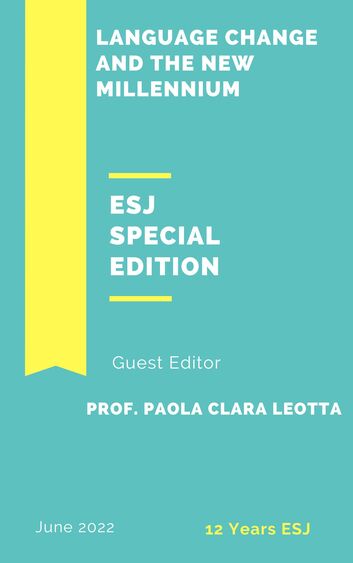COVID-19 and its Linguistic Variants from “Miss Rona” to “Boomer Remover”
Abstract
The COVID-19 pandemic has had an enormous impact on everyday language and has led to unprecedented linguistic innovation and lexical explosion, ranging from the medicalisation of everyday language to the creation of new word formations that have defined new situations and overcome the fear of an unknown disease. In this paper, after briefly introducing the main linguistic features of English neologisms created to define changes in life style during the pandemic, a survey of the main English monikers coined to rename COVID-19 will be given taking into account the most recent studies on the subject.
Downloads
Metrics
PlumX Statistics
References
2. Al-Azzawi, Q.O. & Ali Haleem, H. (2021). "Do you speak Corona?": Hashtags and Neologisms since the COVID-19 pandemic outbreak. International Journal of Linguistics, Literature and Translation, 4(4), 113-122. https://doi.org/10.32996/ijllt.2021.4.4.12
3. Al-Salman, S. & Haider, A.S. (2021). COVID-19 trending neologisms and word formation process in English. Russian Journal of Linguistics, 25(1), 24-42. https://doi.org/10.22363/2687-0088-2021-25-1-24-42
4. Ayalon, L., Chasteen, A., Diehl, M., Levy, B.R., Neupert, S.D., Rothermund, K., Tesch-Römer ,C., Wahl, H.W. (2020). Aging in times of COVID-19 pandemic: avoiding ageism and fostering intergenerational solidarity. The Journals Gerontology: Series B, 76(2), 49-52. https://doi.org/10.1093/geronb/gbaa051
5. Beliaeva, N. (2019). Blending creativity and productivity: on the issue of delimiting the boundaries of blends as a type of word formation. Lexis, 14, 1-22. https://doi.org/10.4000/lexis.4004
6. Cahapay, M.B. (2020). Trending phrases, names and hashtags related to COVID-19 in the Philippines: the language of social crises. Muallim Journal of Social Science and Humanities, 4(4), 1-9. https://doi.org/10.33306/mjssh/91
7. Center for Disease Control and Prevention (2021). Vaccine are effective. Retrieved at https://www.cdc.gov/coronavirus/2019-ncov/vaccines/effectiveness/index.html
8. Crystal, D. (2001). Language and the Internet. Cambridge: Cambridge University Press.
9. Crystal, D. (2008). A Dictionary of Linguistics and Phonetics, 6th edition. London: Blackwell Publishing.
10. Crystal, D. (2020, May 20). Covocabulary. Fifteeneightyfour. Retrieved at http://www.cambridgeblog.org/2020/05/covocabulary/
11. Community Security Trust (2020). Coronavirus and the plague of Antisemitism. Retrieved at https://cst.org.uk/data/file/d/9/Coronavirus%20and%20the%20plague%20of%20antisemitism.1586276450.pdf
12. Dalzell, T. (2014). Vietnam war slang: a dictionary on historical principles. London; New York: Routledge.10.4324/9781315766911
13. Dickson, P. (2011). War slang: American fighting words and phrases since the Civil War. Mineola, NY: Dover.
14. Fraser, S. et al. (2020). Ageism and COVID-19: what does our society’s response say about us?. Age and Ageing, 49(5), 692-695. https://doi.org/10.1093/ageing/afaa097
15. Gilman, S.L. (2021). Placing the blame for COVID-19 in and on ultra-orthodox communities. Modern Judaism, 41(1), 1-30. https://doi.org/10.1093/mj/kjaa021
16. Haddad Haddad, A. & Montero-Martínez, S. (2020). COVID-19: a metaphor-based neologism and its translation into Arabic. Journal of Science and Communication, 19(05), 1-2. https://doi.org/10.22323/2.19050201
17. Hay, M. (2020). Holocough went from anti-Semitic threat to COVID-19 truther rallying cry. The Daily Beast. Retrieved at https://www.thedailybeast.com/how-holocough-went-from-anti-semitic-threat-to-covid-truther-rallying-cry
18. Jimenez‐Sotomayor, M., Gomez-Moreno, C. & Soto-Perez-de-Celis, E. (2020). Coronavirus, ageism and tweets: an evaluation of tweets about older adults and COVID-19. Journal of the American Geriatrics Society, 68(8), 1661-1165. https://doi.org/10.1111/jgs.16508
19. Kemmelmeier, M. & Jami, W.A. (2021). Mask wearing as cultural behavior: An investigation across 45 U.S. States during the COVID-19 pandemic. Frontiers in Psychology, 12, 648692 https://doi.org/10.3389/fpsyg.2021.648692
20. Kurilla, R. (2021). “Kung Flu”- The dynamics of fear, popular culture, and authenticity in the anatomy of populist communication. Frontiers in Communication, 6(624643).
https://doi.org/10.3389/fcomm.2021.624643
21. Lawson, R. (2020, April 28). Coronavirus has led to an explosion of new words and phrases – and that helps us cope. The Conversation. Retrieved at https://theconversation.com/coronavirus-has-led-to-an-explosion-of-new-words-and-phrases-and-that-helps-us-cope-136909
22. Lillo, A. (2020). COVID-19, the beer flu; or, the disease of many names. Lebend Sprachen, 65(2), 411-437. https://doi.org/10.1515/les-2020-0021
23. Nabila, E. & Abdulrahman, T.R. (2021). An analysis of new English words created during COVID-19. Englisia: Journal of Language, Education and Humanities, 9(1), 19-32.
https://doi.org/10.22373/ej.v9i1.9035
24. Orel, A. & Vasik, Y. (2021). Language of Corona-Twitter: COVID-19 neologisms. Interconf, 71, 158-174.
https://doi.org/10.51582/interconf.19-20.08.2021.015
25. Oxford Languages (2020). Words an of unprecedented year. Oxford. Retrieved at https://languages.oup.com/word-of-the-year/2020/
26. Rauschnabel, P.A., Sheldon, P., & Herzfeldt, E. (2019). What motivates users to hashtag on social media?. Psychology & Marketing, 36(5), 473-488. https://doi.org/10.1002/mar.21191
27. Ro, C. (2020, May 25). Why we’ve created new language and coronavirus. Worklife. Retrieved at https://www.bbc.com/worklife/article/20200522-why-weve-created-new-language-for-coronavirus
28. Roig-Marín, A. (2021). Blending and compounding in English coroneologims. Brno Studies in English, 47(1), 31-45. https://doi.org/10.5817/BSE2021-1-3
29. Sipocz, D., Freeman, J.D. & Elton J. (2021). “A toxic trend”: Generational conflict and connectivity in Twitter discourse under #BoomerRemover hashtag. The Gerontologist, 61(2), 166-175. https://doi.org/10.1093/geront/gnaa177
30. Skipper, A.D. & Rose, D.J. (2021). #BoomerRemover: COVID-19, ageism, and the intergenerational twitter response, Journal of Aging Studies, 57, 1-6. https://doi.org/10.1016/j.jaging.2021.100929
31. Thorne, T. (2020, March 31). #Coronaspeak – the language of Covid-19 goes viral. Language and Innovation. Retrieved at https://language-and-innovation.com/2020/03/31/coronaspeak-the-language-of-covid-19-goes-viral/
32. Tsao, S.F., Chen H, Tisseverasinghe, T., Yang Y., Li, L., Butt Z.A. (2021). What social media told us in the time of COVID-19: a scoping review. The Lancet Digital health, 3(3), 175-194. https://doi.org/10.1016/S2589-7500(20)30315-0
33. WHO (2015). WHO issues best practices for naming new human infectious diseases. Retrieved at https://www.who.int/news/item/08-05-2015-who-issues-best-practices-for-naming-new-human-infectious-diseases
34. WHO (2020). Naming the coronavirus disease (COVID-19) and the virus that causes it. Retrieved at
https://www.who.int/emergencies/diseases/novel-coronavirus-2019/technical-guidance/naming-the-coronavirus-disease-(covid-2019)-and-the-virus-that-causes-it
35. Zimmer, B. (2020, December 7). From ‘Covidiot’ to ‘Gleefreshing’. It was a lively year for word creation. Beyond Wordplay. Retrieved at https://beyondwordplay.com/from-covidiot-to-gleefreshing-it-was-a-lively-year-for-word-creation-2cf92a8d57c7
Copyright (c) 2022 Tatiana Canziani

This work is licensed under a Creative Commons Attribution-NonCommercial-NoDerivatives 4.0 International License.








